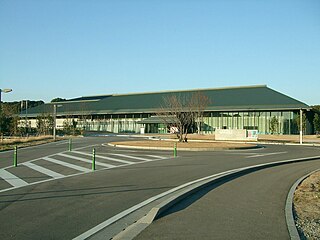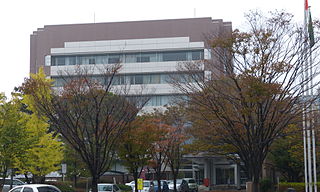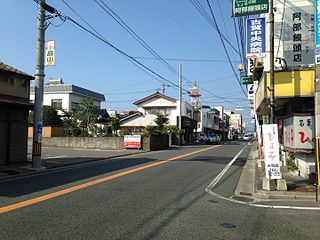
Fukuoka is the sixth-largest city in Japan and the capital city of Fukuoka Prefecture, Japan. The city is built along the shores of Hakata Bay, and has been a center of international commerce since ancient times. The area has long been considered the gateway to the country, as it is the nearest point among Japan's main islands to the Asian mainland. Although humans occupied the area since the Jomon period, some of the earliest settlers of the Yayoi period arrived in the Fukuoka area. The city rose to prominence during the Yamato period. Because of the cross-cultural exposure, and the relatively great distance from the social and political centers of Kyoto, Osaka, and later, Edo (Tokyo), Fukuoka gained a distinctive local culture and dialect that has persisted to the present.

Fukuoka Prefecture is a prefecture of Japan located on the island of Kyūshū. Fukuoka Prefecture has a population of 5,109,323 and has a geographic area of 4,986 km2. Fukuoka Prefecture borders Saga Prefecture to the southwest, Kumamoto Prefecture to the south, and Ōita Prefecture to the southeast.

Hakata-ku (博多区) is a ward of the city of Fukuoka in Fukuoka Prefecture, Japan.

Ōkawa is a city located in Fukuoka Prefecture, Japan. As of 1 February 2024, the city had an estimated population of 31,605 in 13984 households, and a population density of 940 persons per km². The total area of the city is 33.62 km2 (12.98 sq mi).

Ogōri is a city located in Fukuoka Prefecture, Japan. As of 1 February 2024, the city had an estimated population of 59,590 in 25998 households, and a population density of 1309 persons per km². The total area of the city is 45.51 km2 (17.57 sq mi).

Chikushino is a city in Fukuoka Prefecture, Japan. As of 29 February 2024, the city had an estimated population of 106,513 in 48029 households, and a population density of 1200 persons per km2. The total area of the city is 87.73 km2 (33.87 sq mi).

Kasuga is a city located in Fukuoka Prefecture, Japan. As of 31 March 2024, the city had an estimated population of 111,840 in 50874 households, and a population density of 260 persons per km². The total area of the city is 14.145 km2 (5.461 sq mi).

Koga is a city located in Fukuoka Prefecture, Japan. As of 29 February 2024, the city had an estimated population of 59,282 in 26981 households, and a population density of 1400 persons per km². The total area of the city is 42.07 km2 (16.24 sq mi).

Hakata Station is a major railway station in Hakata-ku, Fukuoka, Japan. It is the largest and busiest railway terminal in Kyushu, and is a gateway to other cities in Kyushu for travelers coming from Honshu by rail travel. The San'yō Shinkansen from Osaka ends at this station.

The Hakata-Minami Line is an 8.5 km (5.3 mi) long railway line in Fukuoka Prefecture, Japan, connecting Hakata Station in Fukuoka with Hakata-Minami Station in Kasuga. It is operated by the West Japan Railway Company.

Umi is a town located in Kasuya District, Fukuoka Prefecture, Japan. As of 31 March 2024, the town had an estimated population of 36,907 in 16691 households, and a population density of 1200 persons per km². The total area of the town is 30.21 km2 (11.66 sq mi)

Shingū is a town located in Kasuya District, Fukuoka Prefecture. As of 29 February 2024, the town had an estimated population of 33,142 in 13664 households, and a population density of 1800 persons per km². The total area of the town is 18.93 km2 (7.31 sq mi), and includes the island Ainoshima.

Kotake is a town located in Kurate District, Fukuoka Prefecture, Japan. As of 29 February 2024, the town had an estimated population of 6983 in 3374 households, and a population density of 490 persons per km2. The total area of the town is 14.28 km2 (5.51 sq mi).

Kurate is a town located in Kurate District, Fukuoka Prefecture, Japan. As of 31 January 2024, the town had an estimated population of 14,988 in 7442 households, and a population density of 420 persons per km². The total area of the town is 35.60 km2 (13.75 sq mi).

Kumenan is a town located in Kume District, Okayama Prefecture, Japan.As of 31 December 2022, the town had an estimated population of 4,483 in 2192 households and a population density of 57 persons per km2. The total area of the town is 78.65 square kilometres (30.37 sq mi). Kumenan is known as the birthplace of Honen, the founder of the Jodo sect of Buddhism.

Fukutsu is a city located in Fukuoka Prefecture, Japan. As of 29 February 2024, the city had an estimated population of 68,834 in 31114 households, and a population density of 1300 persons per km2. The total area of the city is 52.76 km2 (20.37 sq mi).
Nakasu (中洲) is the red-light district which exists between the sandbank of the Naka River and the Hakata River in Fukuoka City, Fukuoka Prefecture, Japan. It is named after a popular, but very short-lived, entertainment quarter of Edo, which existed in the late 18th century. The name "Nakasu" can be translated as "the island in the middle", as Nakasu is an island between two rivers.

Misaki is a town located in Kume District, Okayama Prefecture, Japan. As of 31 December 2022, the town had an estimated population of 13,060 in 5867 households and a population density of 56 persons per km2. The total area of the town is 232.17 square kilometres (89.64 sq mi).

Kushida Shrine Station is a subway station on the Fukuoka City Subway Nanakuma Line in Hakata-ku, Fukuoka in Japan.
























